


This article delves into the crucial role of monoclonal antibodies (mAbs) in clinical research, underscoring their importance in treating a range of health conditions. By exploring the innovative therapies these mAbs represent, it highlights their mechanisms of action and the clinical outcomes that showcase their effectiveness in enhancing patient care across various diseases.
In the ever-evolving Medtech landscape, mAbs stand out as pivotal tools in addressing significant challenges in healthcare. Their unique ability to target specific pathways in disease processes not only improves treatment efficacy but also minimizes side effects, making them a preferred choice in modern therapeutics. As we examine the impact of these therapies, it becomes evident that their integration into clinical practice is not just beneficial but essential for advancing patient outcomes.
The collaboration between researchers and healthcare providers is vital in harnessing the full potential of mAbs. By sharing insights and data, stakeholders can drive innovation and ensure that these therapies reach the patients who need them most. As we move forward, it is imperative to foster partnerships that will enhance the development and application of monoclonal antibodies in clinical settings.
The landscape of clinical research is rapidly evolving, especially in the realm of monoclonal antibodies (mAbs), which stand at the forefront of innovative therapies for various diseases. These essential drugs, characterized by their suffix "mab," hold the potential to revolutionize treatment protocols, offering significant benefits such as targeted therapies for cancer and autoimmune disorders.
However, as the race to bring these life-saving treatments to market intensifies, pressing questions emerge regarding the efficiency of current clinical trial processes and their implications for patient access. How can stakeholders effectively navigate the complexities of this dynamic field to ensure timely and effective patient care?
bioaccess® leverages its extensive expertise in early-phase clinical research to accelerate the development of drugs ending in mab. By taking advantage of Colombia's competitive benefits—such as significant cost savings exceeding 30% compared to North America and Western Europe, along with regulatory efficiency that enables ethical approvals in just 90 to 120 days—bioaccess® empowers mAb developers to swiftly bring innovative therapies to market. This rapid turnaround is essential for developers who aim to provide individuals with access to advanced treatments much earlier than traditional pathways would permit.
The streamlined processes not only enhance the speed of clinical trials but also significantly boost recruitment efficiency. Partnerships have demonstrated over a 50% reduction in recruitment time while maintaining an impressive 95% participant retention rate. Colombia's healthcare system, ranked #22 globally by the World Health Organization, supports this recruitment by offering access to a diverse population, with approximately 95% covered under universal healthcare.
Moreover, bioaccess®'s collaboration with Caribbean Health Group seeks to establish Barranquilla as a premier destination for clinical trials in Latin America, further enhancing the region's attractiveness for clinical research. The R&D tax incentives available in Colombia, including a 100% tax deduction for investments in science and technology, further motivate companies to conduct trials in this region. Such agility in clinical research is crucial in a landscape where timely access to effective therapies can dramatically influence outcomes for individuals. As industry specialists emphasize, 'The regulatory pace in Latin America is a game-changer for drugs ending in mab development, enabling faster patient access to life-saving solutions.
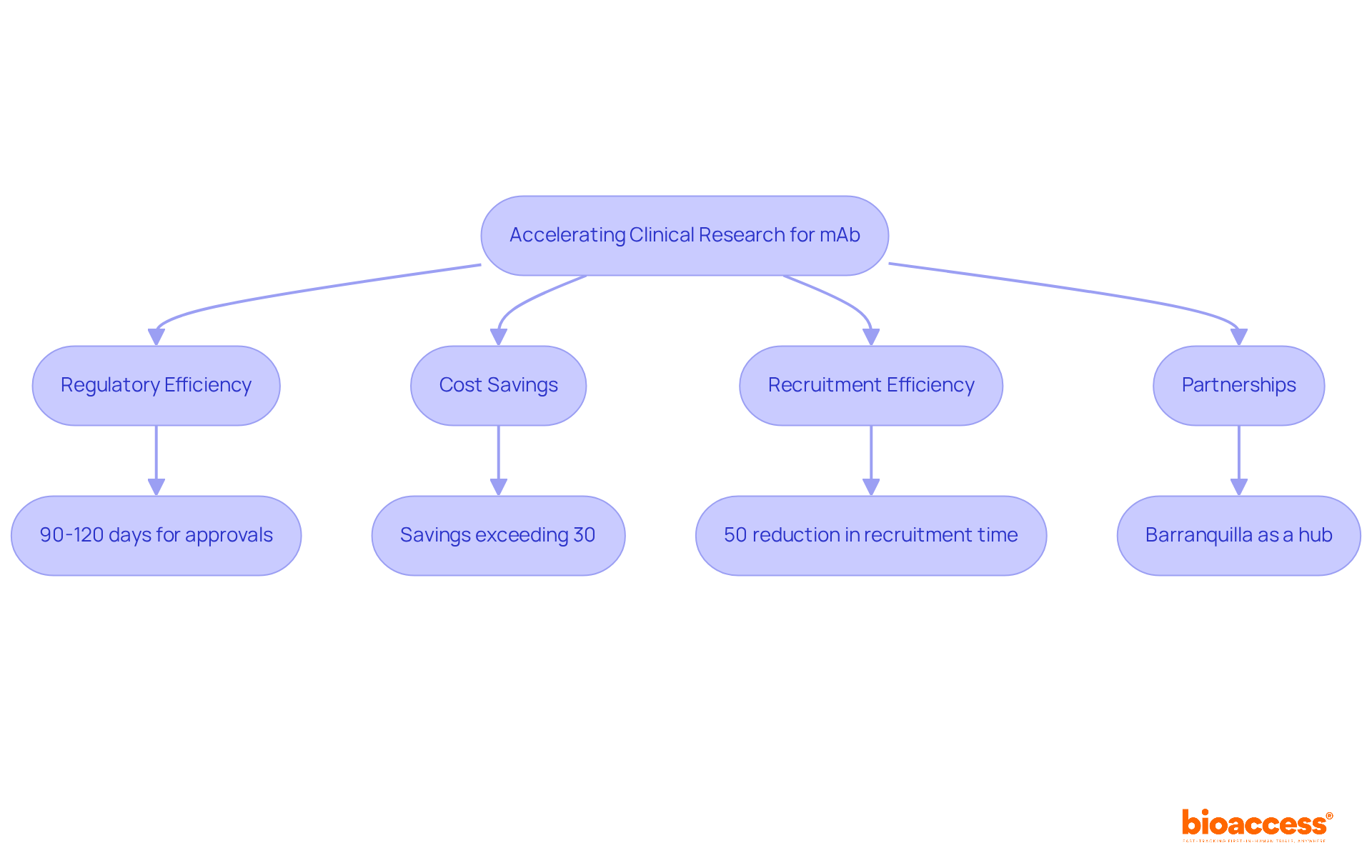
Trastuzumab, commercially known as Herceptin, is a monoclonal antibody and one of the drugs ending in mab that specifically targets the HER2 receptor, which is overexpressed in about 25-30% of breast cancers. Its introduction has revolutionized the treatment landscape for HER2-positive breast cancer, leading to remarkable improvements in patient longevity. Clinical trials reveal that when trastuzumab is combined with chemotherapy, it can lower the risk of recurrence by 36-52% and reduce mortality rates by 33-37%. For instance, patients receiving trastuzumab therapy for 12 months experienced a median disease-free interval of 63 months, compared to 54 months for those treated for only 6 months, with a statistically significant difference (p = 0.048). This underscores the critical importance of treatment duration.
Current clinical trials are exploring trastuzumab's effectiveness in both neoadjuvant and adjuvant settings, with evidence suggesting that extended treatment durations are linked to improved outcomes. Oncologists widely acknowledge trastuzumab's pivotal role in enhancing survival rates, particularly in early-stage HER2-positive breast cancer, where survival rates can surpass 90% with appropriate therapy. As research progresses, the emphasis remains on optimizing trastuzumab's application and investigating new combinations to further improve patient outcomes.

Rituximab, known commercially as Rituxan, is among the drugs ending in mab that specifically target the CD20 antigen on B cells. This targeted approach has proven effective in treating non-Hodgkin lymphoma (NHL) and chronic lymphocytic leukemia (CLL). Its mechanism of action involves inducing apoptosis in CD20-positive cells and activating immune responses, which collectively enhance therapeutic outcomes.
Recent clinical studies underscore Rituximab's significant role in improving progression-free outcomes, particularly when combined with chemotherapy protocols. For instance, a trial involving individuals with CLL demonstrated that the combination of Rituximab with fludarabine and cyclophosphamide achieved an overall response rate of 73%, with a complete response rate of 25%. These findings highlight the drug's effectiveness and its importance in treatment regimens.
Moreover, ongoing research continues to explore Rituximab's effectiveness, revealing that patients undergoing maintenance therapy experience enhanced event-free longevity compared to those who do not. Hematologists emphasize that Rituximab, one of the important drugs ending in mab, has the crucial ability to deplete aberrant B cells, establishing it as a cornerstone in the management of CLL and NHL. As the landscape of clinical research evolves, the collaboration among healthcare professionals remains vital in optimizing treatment strategies.
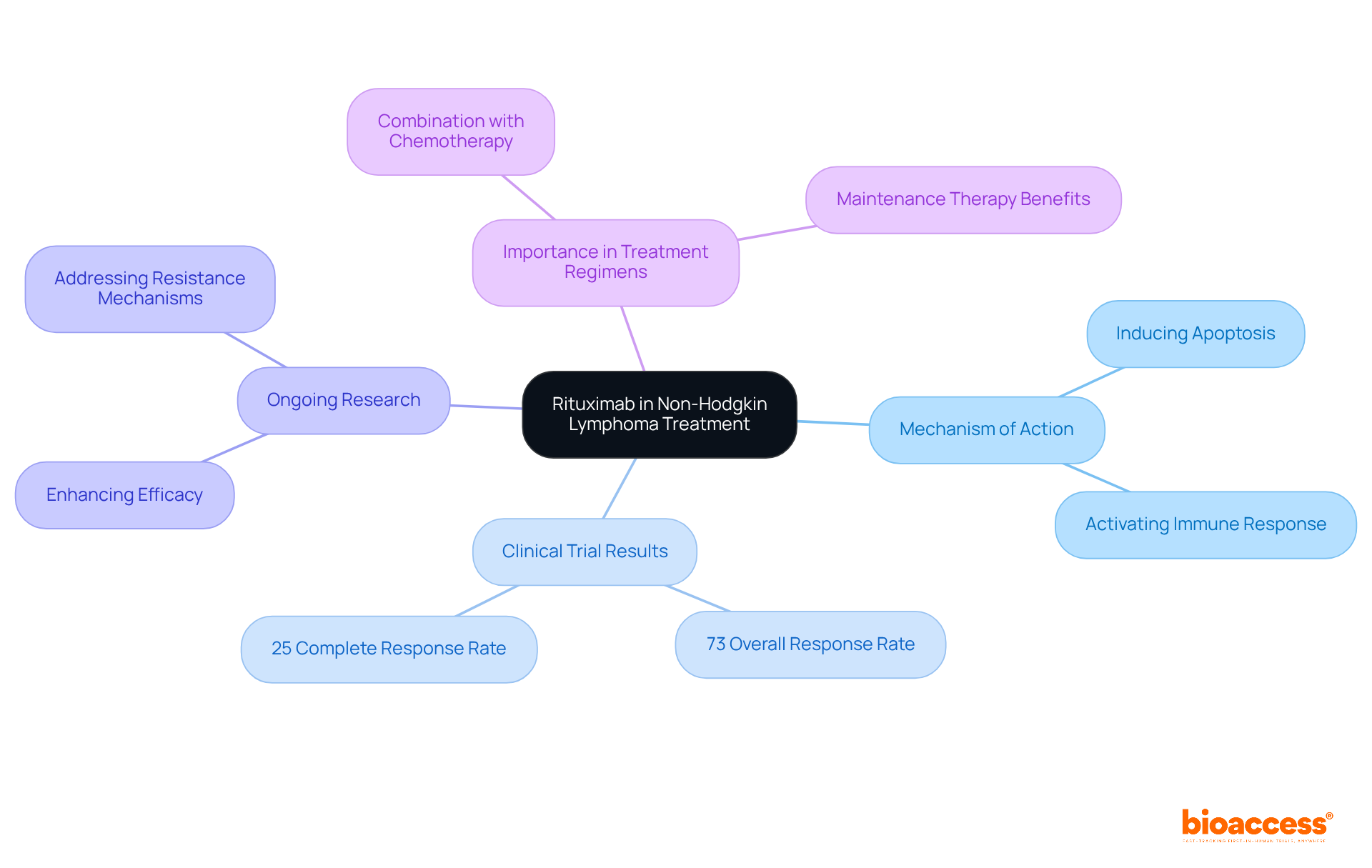
Pembrolizumab, commercially known as Keytruda, is a humanized monoclonal antibody that specifically targets the PD-1 receptor. This innovative therapy significantly enhances the immune system's ability to recognize and destroy cancer cells. Its effectiveness in treating melanoma and non-small cell lung cancer (NSCLC) is well-established, supported by numerous clinical trials. For instance, the KEYNOTE 024 trial revealed a remarkable 5-year overall success rate of 31.9% for patients with high PD-L1 expression, showcasing a substantial improvement over traditional treatments. Additionally, the KEYNOTE 042 trial reported a 5-year survival rate of 21.9%, further illustrating pembrolizumab's efficacy.
A retrospective analysis highlighted a median overall survival of 36 months for patients treated with pembrolizumab, compared to just 19.1 months in another study. The overall response rate (ORR) for pembrolizumab in advanced NSCLC patients stands at 40.0%, with an impressive two-year ORR of 72.2%, underscoring the therapy's long-term effectiveness. Oncologists have noted that the introduction of pembrolizumab has revolutionized treatment paradigms. Dr. Marjorie Green remarked, "Ten years ago, KEYTRUDA became the first anti-PD-1/L1 therapy approved in the United States, setting the stage for transformative breakthroughs in the treatment of advanced melanoma and other types of cancer."
This success has solidified pembrolizumab as a cornerstone in cancer immunotherapy, paving the way for exploring its combination with other therapeutic agents across various malignancies. However, it is crucial to acknowledge that adverse effects were reported in 87% of patients, highlighting the importance of careful selection and monitoring in treatment protocols.

Nivolumab, known commercially as Opdivo, stands as a crucial immune checkpoint inhibitor targeting PD-1, similar to pembrolizumab. Its authorization for advanced melanoma and non-small cell lung cancer (NSCLC) marks a significant advancement in cancer treatment, showcasing notable improvements in overall survival rates. Recent clinical trials reveal that nivolumab can elicit enduring responses in patients, with some individuals maintaining these benefits even after treatment concludes. Notably, research indicates a 5-year overall success rate of 48% for patients receiving nivolumab in combination with ipilimumab, compared to just 31.4 months for those on anti-PD-1 monotherapy.
Moreover, ongoing studies are exploring nivolumab's effectiveness in combination therapies, potentially enhancing its therapeutic impact. As Robert G.V. has historically noted, early clinical responses serve as vital indicators of long-term prognosis, underscoring nivolumab's pivotal role in contemporary cancer care strategies. The 5-year overall survival rates for responders stand at an impressive 82%, in stark contrast to 40% for non-responders receiving nivolumab plus ipilimumab, further illustrating the power of combination therapy. The exploration of nivolumab in trials like RELATIVITY-047, which compares nivolumab/relatlimab to ipilimumab/nivolumab, highlights its evolving significance in therapeutic approaches.
However, it is crucial to acknowledge the immune-related side effects associated with nivolumab treatment, as these can significantly influence the patient experience and management. Understanding these effects is essential for optimizing treatment strategies and ensuring patient well-being.
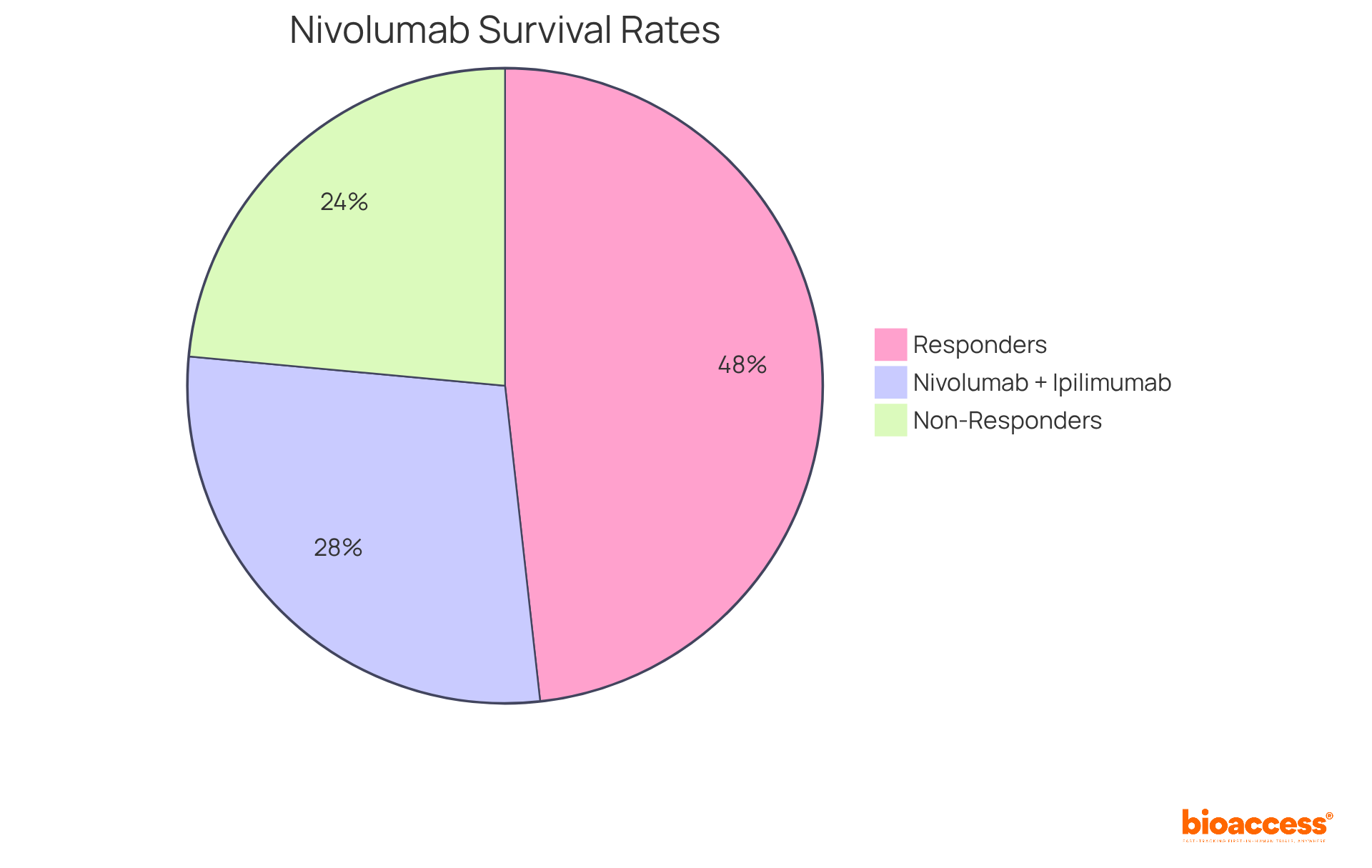
Bevacizumab, commonly known as Avastin, is among the drugs ending in mab that play a crucial role in inhibiting vascular endothelial growth factor (VEGF), a pivotal element in the process of angiogenesis. By effectively blocking VEGF, bevacizumab prevents the formation of new blood vessels that tumors rely on for growth and metastasis. This medication, which includes drugs ending in mab, is utilized in the treatment of various cancers, such as:
Clinical studies have shown that when used in conjunction with chemotherapy, bevacizumab can significantly enhance progression-free outcomes. However, the impact of this treatment on overall longevity remains a topic of ongoing research, highlighting the need for continued exploration in the field. As we navigate the complexities of cancer treatment, understanding the role of such therapies is essential for advancing clinical research and improving patient outcomes.
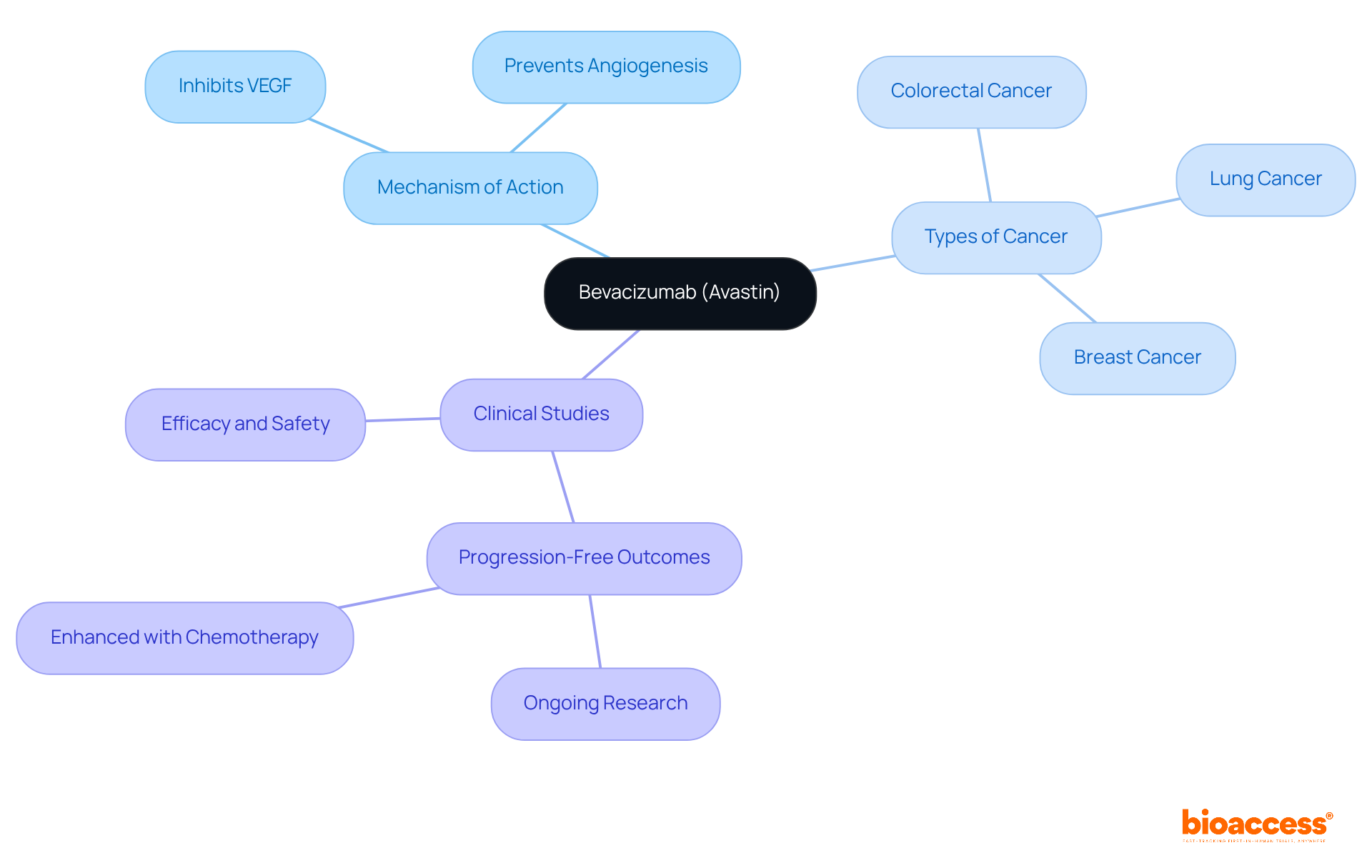
Atezolizumab, commercially known as Tecentriq, is a monoclonal antibody that specifically targets PD-L1, a protein crucial for inhibiting immune responses against tumors. This therapy has gained approval for treating both urothelial carcinoma and non-small cell lung cancer (NSCLC). Recent clinical trials have shown that atezolizumab significantly enhances overall survival (OS) and progression-free survival (PFS) in individuals with advanced disease.
For instance, in the IMvigor 210 trial, atezolizumab demonstrated a 15% response rate in patients with metastatic urothelial carcinoma (mUC), with a notable hazard ratio of 0.88 for OS (95% CI [0.83, 0.94]). This indicates a substantial advantage in longevity compared to conventional treatments. Furthermore, its efficacy extends to NSCLC, where the phase III OAK trial revealed that atezolizumab outperformed docetaxel in survival outcomes, irrespective of PD-L1 expression or histology.
Current studies are exploring the potential of atezolizumab in combination therapies, including promising results when paired with agents like bevacizumab, which may enhance its efficacy and broaden its application in cancer management protocols. Oncologists emphasize that the introduction of atezolizumab marks a significant breakthrough in treating cancers with previously limited options, highlighting its potential to revolutionize patient care.

Certolizumab pegol, known commercially as Cimzia, is a monoclonal antibody specifically designed to target tumor necrosis factor-alpha (TNF-α), a crucial mediator in inflammatory processes. This medication plays a vital role in treating autoimmune diseases, including rheumatoid arthritis, Crohn's disease, and psoriasis. Clinical studies have consistently shown that certolizumab pegol not only reduces disease activity but also significantly enhances the quality of life for patients.
What sets certolizumab pegol apart is its unique PEGylated formulation, which allows for less frequent dosing. This innovation not only improves patient adherence but also addresses a common challenge in the management of chronic conditions. As we navigate the complexities of the Medtech landscape, understanding the implications of such advancements is essential for clinical research and practice.
In summary, the importance of collaboration in advancing treatment options cannot be overstated. As we look to the future, embracing innovative therapies like certolizumab pegol will be crucial in overcoming the challenges faced in clinical research and improving patient outcomes.

Omalizumab, known commercially as Xolair, is a monoclonal antibody that specifically targets immunoglobulin E (IgE), a key player in allergic responses. This medication is authorized for managing moderate to severe persistent asthma and chronic idiopathic urticaria, showcasing remarkable efficacy in clinical trials. For instance, research indicates that individuals receiving omalizumab experienced a significant reduction in asthma attacks, with over 70% of participants in the STELLAIR study reporting a ≥40% decline in annual exacerbation rates after just 4-6 months of treatment.
Moreover, long-term data reveal that omalizumab not only enhances lung function but also improves the overall quality of life for those with severe allergic asthma, with sustained benefits observed for up to nine years. In pediatric populations, the mean peak expiratory flow (PEF) increased from baseline by 37.1 L/min at Month 24, underscoring its effectiveness in younger patients. Recent studies are also expanding its application to food allergies, demonstrating a six-fold increase in tolerance to peanut protein among treated individuals compared to those on placebo.
However, it is crucial to acknowledge that anaphylaxis has been reported in 0.1% of patients during premarketing clinical trials. The most common adverse reactions among XOLAIR-treated patients included:
This versatility highlights omalizumab's potential as a cornerstone in managing various allergic conditions, making it a vital consideration for clinical research and practice. Furthermore, XOLAIR is not recommended for the emergency management of allergic reactions, including anaphylaxis, with 60% to 70% of anaphylaxis incidents occurring within the initial three doses, necessitating careful observation in a healthcare setting.
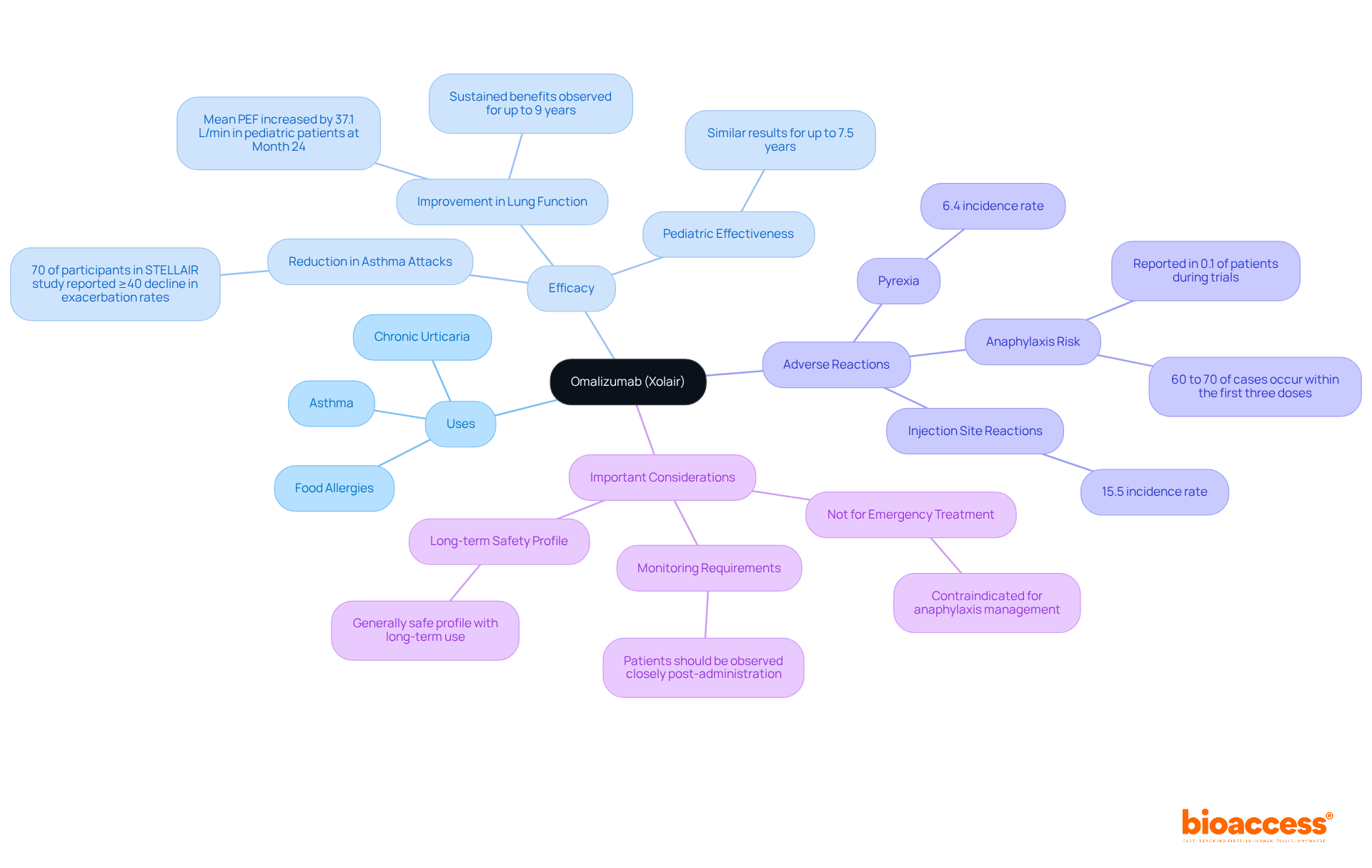
Eculizumab, marketed as Soliris, is classified among the drugs ending in mab that inhibit complement protein C5. It plays a crucial role in managing rare blood disorders like paroxysmal nocturnal hemoglobinuria (PNH) and atypical hemolytic uremic syndrome (aHUS). Clinical studies have shown that eculizumab significantly improves hemolysis and renal function in patients with PNH. For example, the 301 study revealed that 246 participants experienced fewer instances of breakthrough hemolysis with ravulizumab compared to eculizumab, underscoring the effectiveness of these treatment options.
The introduction of drugs ending in mab, particularly eculizumab, has transformed the management of these rare conditions, providing patients with life-saving alternatives. Ongoing research emphasizes the importance of genetic factors, particularly three distinct C5 polymorphisms:
These polymorphisms may lead to ineffective treatment, highlighting the necessity for personalized therapeutic approaches.
However, the annual costs of eculizumab and ravulizumab, ranging from $474,284 to $569,140, present a significant consideration for clinical decision-makers. While eculizumab has addressed critical gaps in care, it is essential to acknowledge the reported rates of serious infections associated with its use, which must be carefully weighed against its benefits. This innovative treatment, involving drugs ending in mab, not only fills vital gaps in care but also sets new standards in the management of PNH and aHUS.
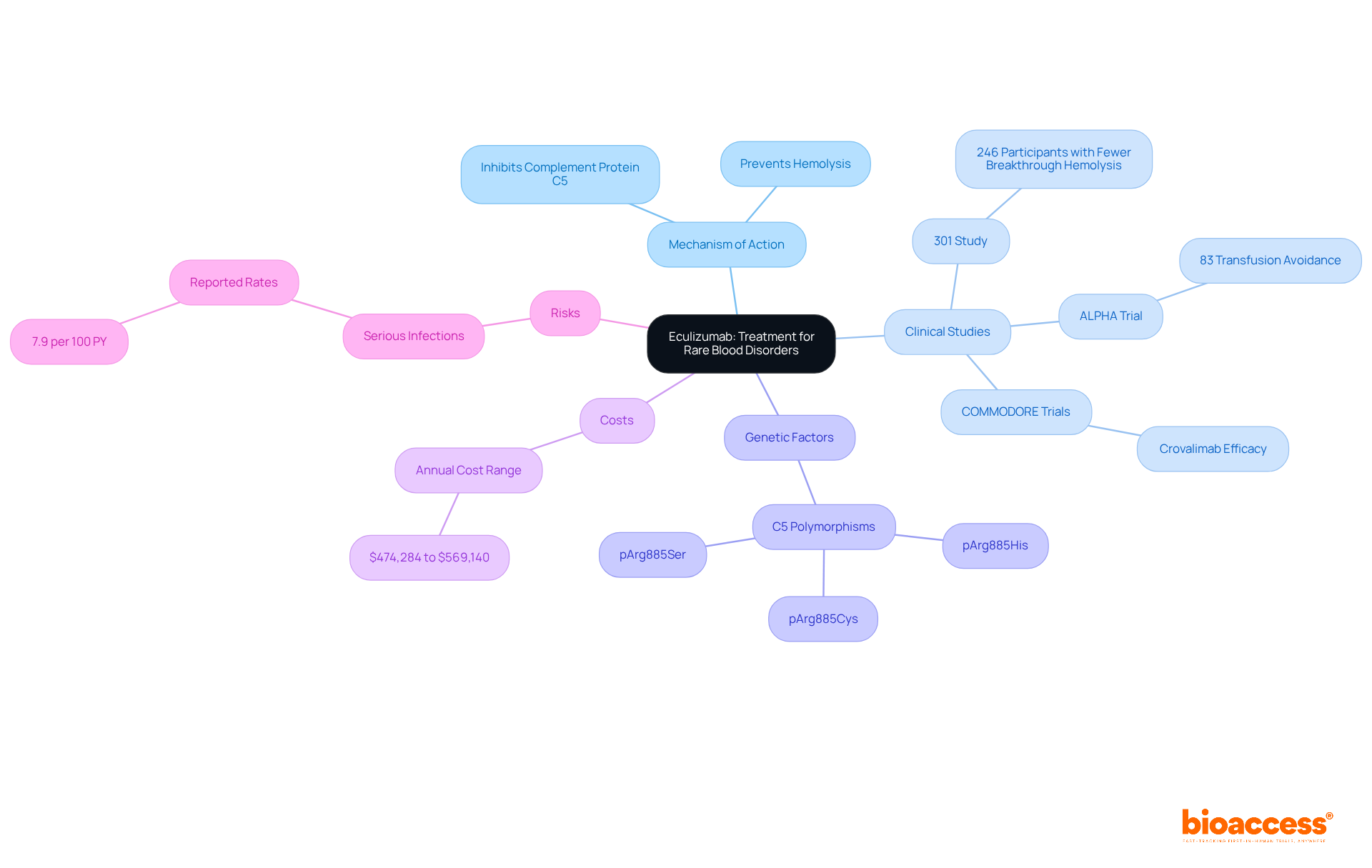
The exploration of monoclonal antibodies (mAbs) has unveiled their significant impact on clinical research and patient care. These essential drugs, defined by their unique mechanisms of action, play a pivotal role in treating a range of conditions, from cancers to autoimmune diseases. The advancements in mAb therapies highlight the necessity of innovative research and efficient clinical trial processes, particularly as demonstrated by bioaccess® in expediting drug development.
Throughout this discussion, key mAbs such as Trastuzumab, Rituximab, and Pembrolizumab have been examined, showcasing their effectiveness in treating specific diseases. The data presented illustrates notable improvements in patient outcomes and survival rates, alongside the potential for combination therapies that enhance therapeutic efficacy. Furthermore, the strategic advantages offered by regions like Colombia, with their supportive regulatory frameworks and cost efficiencies, underscore the evolving landscape of clinical research for mAbs.
Looking ahead, collaboration among researchers, healthcare professionals, and regulatory bodies will be crucial in advancing treatment options and improving patient access to these life-saving therapies. The commitment to exploring new combinations and optimizing existing therapies can pave the way for groundbreaking advancements in medicine. Embracing the potential of monoclonal antibodies is essential not only for enhancing patient care but also for shaping the future of clinical research as it seeks to address unmet medical needs.
What is bioaccess® and how does it support monoclonal antibody development?
bioaccess® is an organization that leverages its expertise in early-phase clinical research to accelerate the development of monoclonal antibodies (mAbs). It offers significant cost savings and regulatory efficiency, enabling ethical approvals in just 90 to 120 days, which allows developers to bring innovative therapies to market more quickly.
What are the advantages of conducting clinical trials in Colombia through bioaccess®?
Conducting clinical trials in Colombia through bioaccess® provides over 30% cost savings compared to North America and Western Europe, enhances recruitment efficiency with a 50% reduction in recruitment time, and maintains a 95% participant retention rate. Colombia's universal healthcare system supports access to a diverse population for trials.
How does bioaccess® aim to enhance clinical research in Latin America?
bioaccess® collaborates with Caribbean Health Group to establish Barranquilla as a premier destination for clinical trials in Latin America. This initiative aims to enhance the region's attractiveness for clinical research by leveraging Colombia's R&D tax incentives, including a 100% tax deduction for investments in science and technology.
What is trastuzumab and what role does it play in breast cancer treatment?
Trastuzumab, commercially known as Herceptin, is a monoclonal antibody that targets the HER2 receptor, which is overexpressed in 25-30% of breast cancers. It has significantly improved patient longevity and, when combined with chemotherapy, can lower the risk of recurrence by 36-52% and reduce mortality rates by 33-37%.
What are the findings from clinical trials involving trastuzumab?
Clinical trials indicate that patients receiving trastuzumab therapy for 12 months have a median disease-free interval of 63 months compared to 54 months for those treated for only 6 months. Ongoing trials are also exploring its effectiveness in neoadjuvant and adjuvant settings, with evidence suggesting that longer treatment durations lead to better outcomes.
What is rituximab and how is it used in treating non-Hodgkin lymphoma?
Rituximab, known as Rituxan, is a monoclonal antibody targeting the CD20 antigen on B cells, effectively treating non-Hodgkin lymphoma (NHL) and chronic lymphocytic leukemia (CLL). It works by inducing apoptosis in CD20-positive cells and activating immune responses.
What are the results of recent studies on rituximab's effectiveness?
Recent studies show that combining rituximab with other chemotherapy drugs can achieve an overall response rate of 73% in CLL patients, with a complete response rate of 25%. Ongoing research indicates that maintenance therapy with rituximab enhances event-free longevity for patients.
Why is rituximab considered a cornerstone in the management of CLL and NHL?
Rituximab is deemed a cornerstone in managing CLL and NHL due to its ability to deplete aberrant B cells and significantly improve therapeutic outcomes, particularly when used in combination with chemotherapy protocols.